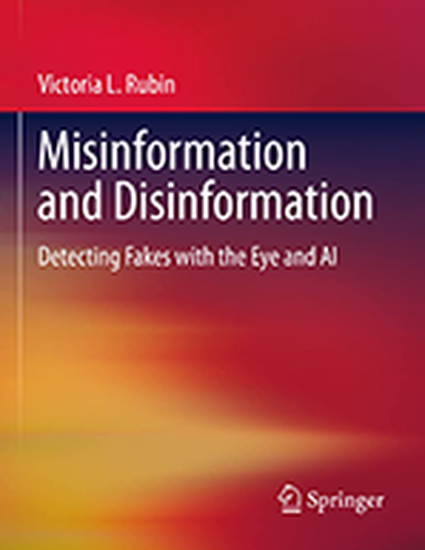
Book
Misinformation and Disinformation: Detecting Fakes with the Eye and AI
(2022)
Abstract
How do we detect, deter, and prevent the spread of mis- and disinformation
with the human eye and AI? How does theory inform the practice, and how do the
evidence-based research and best practices in lie-catching and truth-seeking
professions—inform AI? The book looks into well-established human practices
such as the routines and processes used in detective work, journalism, and scientific
inquiry, and how they contribute toward innovative AI solutions. The book explains
the principles, inner workings, and recent evolution of five types of state-of-the-art
AI technologies suitable for curtailing the spread of mis- and disinformation:
automated deception detectors, clickbait detectors, satirical fake detectors, rumor
debunkers, and computational fact-checking tools.
Keywords
- Misinformation,
- Disinformation,
- Fake news,
- False news,
- Falsehoods,
- Infodemic,
- Satire,
- Clickbait,
- Information manipulation,
- Online deception,
- Library and Information Science,
- LIS,
- Journalism,
- Psychology,
- Communication,
- Social Sciences,
- Infodemiology,
- Natural Language Processing,
- NLP,
- Artificial Intelligence,
- AI,
- Machine Learning,
- ML,
- Algorithms,
- Automated Deception Detection,
- News verification,
- Automated fact-checking,
- Satire detection,
- Clickbait identification
Disciplines
- Digital Humanities,
- Film and Media Studies,
- Philosophy,
- Digital Communications and Networking,
- Commercial Law,
- Marketing Law,
- Privacy Law,
- Linguistic Anthropology,
- Social and Cultural Anthropology,
- Communication Technology and New Media,
- Health Communication,
- Journalism Studies,
- Mass Communication,
- Public Relations and Advertising,
- Social Influence and Political Communication,
- Social Media,
- Speech and Rhetorical Studies,
- Library and Information Science,
- Anthropological Linguistics and Sociolinguistics,
- Applied Linguistics,
- Computational Linguistics,
- Discourse and Text Linguistics,
- Psycholinguistics and Neurolinguistics,
- Cognitive Psychology,
- Social Work,
- Criminology,
- Politics and Social Change,
- Social Control, Law, Crime, and Deviance,
- Social Psychology and Interaction,
- Social Justice and
- Cognitive Science
Publication Date
Summer June 15, 2022
Publisher
Springer Nature
DOI
https://doi.org/10.1007/978-3-030-95656-1
Publisher Statement
Victoria L. Rubin
Misinformation and Disinformation
Detecting Fakes with the Eye and AI
Examines how artificial intelligence (AI) and psychology can aid in detecting
mis-/disinformation and the language of deceit in digital media content
Suggests practical computational means to intervene and curtail the global
‘infodemic’ of fake news
Presents how AI can sift, sort, and shuffle digital content, to reduce the amount of
content needed to be reviewed by humans
This book, geared towards both students and professionals, examines the synthesis
of artificial intelligence (AI) and psychology in detecting mis-/disinformation in digital
media content, and suggests practical means to intervene and curtail this current
global ‘infodemic’. This interdisciplinary book explores technological, psychological,
philosophical, and linguistic insights into the nature of truth and deception, trust and
credibility,cognitive biases and logical fallacies and how, through AI and human
intervention, content users can be alerted to the presence of deception. The author
investigates how AI can mimic the procedures and know-hows of humans,showing
how AI can help spot fakes and how AI tools can work to debunk rumors and fact-
check. The book describes how AI detection systems work and how they fit with
broader societal and individual concerns. Each chapter focuses attention on key
concepts and their inter-connection. The first part of the book seeks theoretical
footing to understand our interactions with new information and reviews relevant
empirical findings in behavioral sciences. The second part is about applied
knowledge.
Edition No: 1
2022. XX, 289 p. 50 illus., 34 illus. in
color.
Printed Book
Hard cover
ISBN 978-3-030-95655-4
64.99 € |£ 54.99 |$ 79.99
69.54 € (D) |71.49 € (A) |CHF 77.00
eBook
ISBN 978-3-030-95656-1
49.99 € |£ 43.99 |
53.49 € (D) |CHF 61.50
MyCopy
ISBN 978-3-030-95657-8
£ 39.99 |
39.99 € (D) |39.99 € (A) |CHF 39.99
Soft cover
ISBN 978-3-030-95658-5
49.99 € |£ 44.99 |
53.49 € (D) |54.99 € (A) |CHF 59.00
Citation Information
Rubin, V. L. (2022). Misinformation and Disinformation: Detecting Fakes with the Eye and AI. Springer Nature, Switzerland. https://doi.org/10.1007/978-3-030-95656-1
